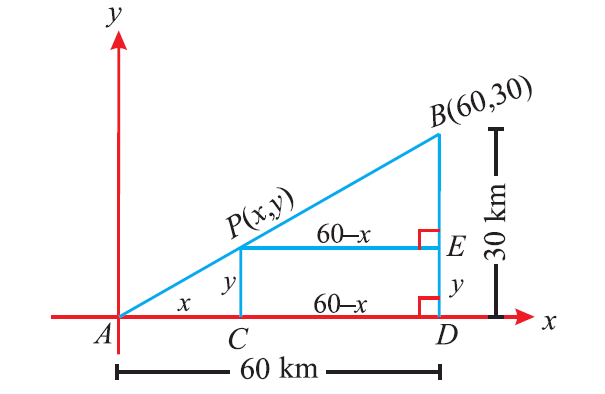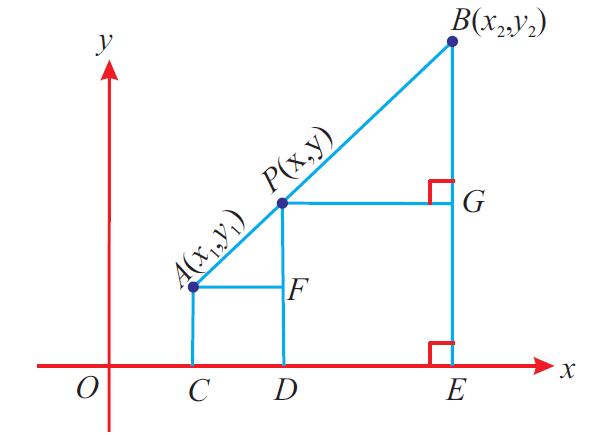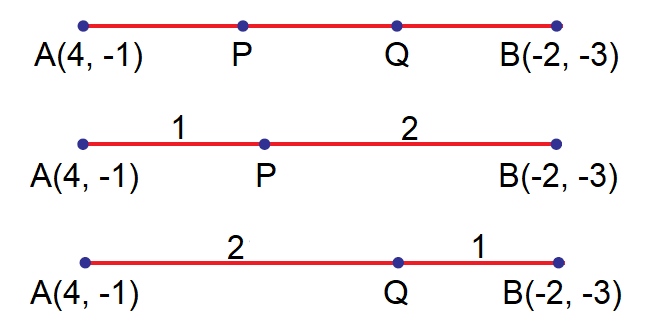SECTION FORMULA
Subscribe to our ▶️ YouTube channel 🔴 for the latest videos, updates, and tips.
Let A and B be two towns. Assume that one can reach town B from A by moving 60 km towards east and then 30 km towards north. A telephone company wants to raise a relay tower at P which divides the line joining A and B in the ratio 1 : 2 internally.
Now, it wants to find the position of P where the relay tower is to be set up. Choose the point A as the origin. Let P(x, y) be the point. Draw the perpendiculars from P and B to the x-axis, meeting it in C and D respectively. Also draw a perpendicular from P to BD, intersecting at E.

Since ΔPAC and ΔBPE are similar, we have
|
|
|
Therefore, the position of the relay tower is at P(20, 10).
Taking the above problem as a model, we shall derive the general section formula.
Let A(x1, y1) and B(x2, y2) be two distinct points such that a point P(x, y) divides AB internally in the ratio l : m.
That is,
AP/PB = l/m

From the diagram above, we get
AF = CD = OD - DC = x - x1
PG = DE = OE - OD = x2 - x
Also,
PF = PD - FD = y - y1
BG = BE - GE = y2 - y
Now, ΔAFP and ΔPGB are similar.
Thus
|
|
|
Thus, the point P which divides the line segment joining the two points A(x1, y1) and B(x2, y2) internally in the ratio l : m is
This formula is known as section formula.
It is clear that the section formula can be used only when the related three points are collinear.
Results
Let AB be a line segment joining the two points A(x1, y1) and B(x2, y2) externally in the ratio l : m, then the point P is :
Solved Problems
Problem 1 :
Find the point which divides the line segment joining the points (3 , 5) and (8 , 10) internally in the ratio 2 : 3.
Solution :
Let A(3, 5) and B(8, 10) be the given points.
Let the point P(x, y) divide the line AB internally in the ratio 2 : 3.

By section formula,
Here (x1, y1) = (3, 5), (x2, y2) = (8, 10), l = 2 and m = 3.
= [2(8) + 3(3)] / (2 + 3), [2(10) + 3(5)] / (2 + 3)
= (16 + 9)/5, (20 + 15)/5
= 25/5, 35/5
= (5, 7)
So, the required point is (5, 7)
Problem 2 :
In what ratio does the point P(-2, 3) divide the line segment joining the points A(-3, 5) and B(4, -9) internally?
Solution :
Given points are A(-3, 5) and B(4, -9).
Let P (-2, 3) divide AB internally in the ratio l : m.

By the section formula,
Here (x1, y1) = (-3, 5) and (x2, y2) = (4, -9).
Equating the x-coordinates, we get
Hence P divides AB internally in the ratio 1 : 6.
Problem 3 :
Find the points of trisection of the line segment joining
(4, -1) and (-2, -3)
Solution :
Let A(4, -1) and B(-2, -3) be the given points.
Let P(x, y) and Q(a, b) be the points of trisection of AB so that
AP = PQ = QB

Hence P divides AB internally in the ratio 1 : 2 and Q divides AB internally in the ratio 2 : 1.
By the section formula, the required points are
Note that Q is the midpoint of PB and P is the midpoint of AQ.
Problem 4 :
Find the coordinates of the point which divides the line segment joining (3, 4) and (–6, 2) in the ratio 3 : 2 externally.
Solution :
Let A(3, 4) and B(-6, 2) be the given points.
Let the point P(x, y) divide the line AB externally in the ratio 3 : 2.

By section formula,
Here (x1, y1) = (3, 4), (x2, y2) = (-6, 2), l = 3 and m = 2.
Problem 5 :
Find the points which divide the line segment joining (-4, 0) and (0, 6) into four equal parts.
Solution :
Let A(-4, 0) and B(0, 6) be the given points.
Let P, Q and R be the three points which divide the line AB into four equal parts.

P divides the line segment in the ratio 1 : 3.
By section formula, point P :
Q divides the line segment in the ratio 2 : 2.
By section formula, point Q :
R divides the line segment in the ratio 3 : 1.
By section formula, point R :
Problem 6 :
A (2, 5), B (-1, 2) and C (5, 8) are vertices of triangle ABC. P and Q are points on AB and AC respectively such that AP : PB = AQ : QC = 1 : 2
a) Find the cooridnates of points P and Q.
b) Show that BC = 3PQ
Solution :
A (2, 5), B (-1, 2) and C (5, 8)
AB, BC and CA are the sides. P is the point on the side of triangle AB and divides the line segment A and B at the ratio of 1 : 2.
a)
Finding the point P :
= (mx2 + nx1)/(m + n), (my2 + ny1)/(m + n)
= (1(-1) + 2(2))/(1 + 2), (1(2) + 2(5))/(1 + 2)
= (-1 + 4)/3, (2 + 10)/3
= (3/3, 12/3)
= (1, 4)
Finding the point Q :
= (1(5) + 2(2))/(1 + 2), (1(8) + 2(5))/(1 + 2)
= (5 + 4)/3, (8 + 10)/3
= (9/3, 18/3)
= (3, 6)
b)
Distance between the points B and C :
B (-1, 2) and C (5, 8)
= √(x2 - x1)2 + (y2 - y1)2
= √(5 + 1)2 + (8 - 2)2
= √62 + 62
= √(36 + 36)
= √72
= 6√2
Distance between the points P and Q :
P(1, 4) Q(3, 6)
= √(3 - 1)2 + (6 - 4)2
= √22 + 22
= √(4 + 4)
= √8
= 2√2
6√2 = 3(2√2)
Hence it is proved.
Subscribe to our ▶️ YouTube channel 🔴 for the latest videos, updates, and tips.
Kindly mail your feedback to v4formath@gmail.com
We always appreciate your feedback.
About Us | Contact Us | Privacy Policy
©All rights reserved. onlinemath4all.com
Recent Articles
-
Quantitative Reasoning Questions and Answers
Dec 13, 25 12:45 PM
Quantitative Reasoning Questions and Answers -
Coin Tossing Probability
Dec 13, 25 10:11 AM
Coin Tossing Probability - Concept - Sample Space - Formula - Solved Problems -
10 Hard SAT Math Questions (Part - 39)
Dec 11, 25 05:59 PM
10 Hard SAT Math Questions (Part - 39)